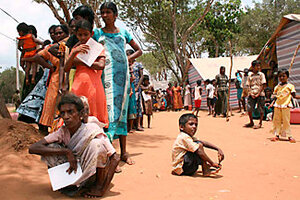Sri Lankan 'detention' camps swell with Tamils
Aid workers struggle to help war-weary refugees as concerns grow about conditions in the shelters as well as timetables for resettlement.

Tamil civilians wait at a refugee camp in northern Sri Lanka on Wednesday. Some 190,000 are believed to have been displaced by civil war, and a huge aid effort is now underway.
Reuters
Colombo, Sri Lanka
A mass outpouring of refugees from a civil war in its final, bloody phase is spurring a huge aid effort for more than 190,000 ethnic Tamils.
By night, bulldozers are clearing more land for vast tented cities being put up during the day on the flatlands of northern Sri Lanka, where the military has corralled the Tamil Tigers along a tiny strip of coastline.
But as authorities brace for more arrivals, aid workers, social activists, and Tamil politicians are voicing mounting concern over conditions in the camps and the government's timetable for returning people to their homes. Critics say that the emergency shelters are becoming open-ended detention centers underwritten by foreign donors.
War-weary refugees are being separated from family members, then denied permission to leave the camps for security reasons. Food parcels have been tossed into hungry crowds, causing at least one deadly stampede. Aid workers warn of poor sanitation, child malnutrition, and inadequate health services.
Last month, a public hospital in Vavuniya, the town with the largest refugee population, admitted 800 patients in a single week, several times its normal intake. All bore the scars of war: gunfire, artillery shells, and land mines.
"There's no food. People can't sleep because of all their trauma," says Veerasingham Anandasangaree, an opposition lawmaker who represents a northern district.
Government and UN officials say that conditions are slowly improving as more foreign aid arrives to supplement local relief efforts. A trickle of vulnerable detainees has been released, as well as UN national staff caught in the fighting, and food distribution has been overhauled. But the huge numbers and their perilous situation are overwhelming.
"These people are in difficult conditions. You rarely have a population coming out [of a war zone] with so many physical injuries," says UN country head Neil Buhne.
Aid, as well as journalists, is being restricted
Independent reporters are barred from the area, ostensibly for security reasons. Authorities have also blocked media access to those injured in the war in other locations.
Heeding international calls, Sri Lanka is allowing greater humanitarian access to the camps, though not to the war zone, where only the International Committee of the Red Cross (ICRC) is present. It has rejected repeated pleas for a pause in the fighting, most recently by UN Secretary-General Ban Ki-moon, who spoke Tuesday to President Mahinda Rajapaksa.
The relief effort in the camps is complicated by uncertainty over the timing of new arrivals. The military says it is close to defeating the Liberation Tigers of Tamil Eelam (LTTE), which has been preventing civilians from fleeing its shrinking stronghold and is forcibly recruiting fighters. The UN estimates that between 50,000 and 100,000 are trapped there.
Those who emerge are exhausted by their ordeal and by months of dodging shelling and surviving on meager rations. Aid workers say malnutrition is more acute among recent arrivals compared with those who came in earlier waves of evacuations.
Crucially, not enough water is available. "The biggest issue is water. The dry season is coming up and this area doesn't have much water at the best of times," says Melanie Brooks, a spokesperson for CARE International, who toured a camp on Thursday.
The LTTE has accused the government of deliberately stopping food and medicine from reaching the war zone. Only one ICRC shipment of 30 tons has been delivered in the last month.
These deprivations make it crucial to scale up aid for evacuees, says Irene Gates, a relief worker in Vavuniya for World Vision. "If we got their basic needs covered, people may lose some of the trauma that you see in their eyes."
Is the North a coveted area or mere 'jungle'?
Even more contentious than upgrading the camps is the government's commitment to returning people to their homes, once the fighting ends. Tamils are deeply suspicious of how the military has depopulated much of the north, known as the Vanni, during its two year campaign and warn that majority Sinhalese could muscle in to what was once a breakaway state under the LTTE, which has fought since 1983 for an independent homeland in the northeast.
Government officials say they aim to resettle 80 percent of displaced Tamils by the end of the year, once the battlefields are demined. A similar program in Sri Lanka's East, where roughly 200,000 were displaced before the military defeated the LTTE in 2007, has already resettled 185,000 people, says Rajiva Wijesinha, head of the government's peace secretariat.
He dismisses the suggestion that migrants covet the undeveloped area. "As far as the Southerners are concerned, the Vanni is the jungle. It's always been seen that way," he says.
Sri Lanka has asked donors to support the resettlement camps. In February, the UN issued a $155 million emergency appeal, of which one-third has been met with pledges. Mr. Buhne says that the UN wants to see the displaced return home as soon as possible and points to the high cost of supplying vast refugee camps.
"It's expensive. You can't keep these people there too long, that's why it's important there are measures put in place really soon to give people the chance to leave these camps," he says.
